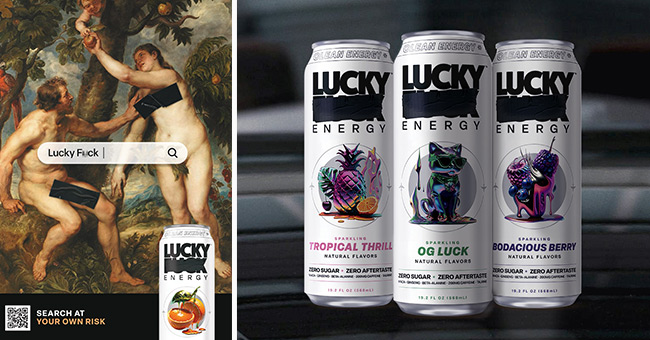Less than a year into its launch, Lucky F*ck Energy is shifting its identity to better balance its explicit branding with mainstream sensibilities.
Now recast as simply Lucky Energy, the brand has “censored” itself with fresh packaging and a digital campaign poking fun at the danger of typing its former name into a web search engine. The revamp comes on the back of a fresh $8 million in a Seed II round led by Austin, Texas-based Brand Foundry Ventures as well as Sugar Capital and Imaginary Ventures, who led Lucky Energy’s previous $4 million raise in November 2023.
The funding will go towards new marketing initiatives as well as expanding the brand’s retail footprint into new markets and building out its sales team.
New CMO Hamid Saify, a former SVP of digital retail at Liquid Death, is leading the “Search at Your Own Risk” advertising campaign. Upon joining the company in February, he spent his first two months trying to reframe how the brand’s original controversial style can be maintained while also “tugging at the emotional heartstrings” that are the root of Lucky Energy’s story.
“I think there’s this tendency to think we’re just trying to be edgy with the name that we’re using,” Saify said. “Yet, once you hear the origin story, everything starts to come together…We’re not just doing stuff for shock value. We’re doing stuff that’s very purposeful.”
Lucky Energy was launched last July by Kate Farms founder Richard Laver whose life has had many ups and downs in which he lived on a beach homeless for a month and survived a plane crash as a child nearly 40 years ago. The brand name is an ode to Laver’s luck and perseverance in overcoming life’s challenges.
The 200 mg caffeine energy drink is made with zero sugar and contains a formulation that includes Maca, Ginseng, Taurine and Beta-Alanine. Currently, Lucky Energy is offered in five flavors: OG Luck, Bodacious Berry, Orange Drizzle, Red Ryder Punch and Tropical Thrill.
The new four-part video ad campaign will progressively roll out in coming weeks on social media platforms with cheeky videos of people describing what happens when you search the brand online. The campaign ushers in Lucky Energy’s packaging rebrand; its 19.2 ounce cans are now “censored” with an image of black tape covering the brand’s expletive. The drink maker also reworked the front-of-can callouts, adding plane imagery (in an ode to Laver’s brush with death) and listing its hero ingredients.
Along with the video series, Lucky Energy is also releasing a series of “wild postings” strategically placed around New York City, Los Angeles and Austin that use fine art as a comparison point of what is socially acceptable to show and talk about in public spaces. The imagery uses the same black tape to censor representations of risque material in Renaissance art.
Although the marketing campaign is part of the brand leaning into the attention economy, Saify said, he also sees it as a progression to “dimensionalize” Lucky Energy so it is not seen as a “one-trick pony that feels predictable.” The “intentional” approach is about bringing awareness to the brand as it targets the competitive landscape of energy drinks.
The energy category shows no signs of slowing with dollar sales accelerating 10.1% and volumes up 3.9% in the last 52-week period ending February 30, according to NielsenIQ scanner data. Category leaders like Monster and Red Bull continue to dominate the field despite the rising demand for fitness-oriented products from brands like Celsius and Nutrabolt’s C4 brand.
Differentiation is important when competing against these category leaders and the rebrand is rooted in building off the “rebelliousness and inspiration” of the brand while also making it a bit “safer” for conventional retailers to put the cans on shelf, Saify said.
Lucky Energy is building off partnership with about 15 Anheuser-Busch DSD houses, to build a distribution network that targets growth in the c-store, independent grocery, and gym and fitness channels in 2024.
Currently the brand operates in the major metro areas of Nashville, Chicago, Southern California and Texas. Lucky Energy has about 25 wholesaler partners including its AB InBev DSD network.
“The plan of attack for this year is to just blitz, blitz, blitz and go as hard as possible to get all these doors opened up,” Saify said.

